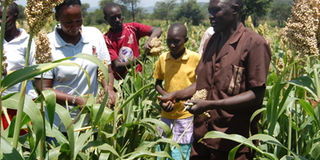Revealed: Only 15pc of farmers use improved sorghum seeds

Sorghum farmers harvesting the crop in Baringo County. Many farmers lack certified seeds to boost production. PHOTO | FRANCIS MUREITHI | NATION MEDIA GROUP
What you need to know:
Sorghum, which is the world fifth most important cereal grain after wheat, maize, rice and barley, is drought, diseases and pest resistant.
According to a 2015 study, sorghum production increased progressively from 2012 in Arid and semi-Arid Lands.
Kenya Breweries Limited requires an estimated 60,000 metric tonnes annually for making sorghum beer.
In a bid to turn sorghum farming into a commercial enterprise, the public sector must support the government’s efforts, an agriculture think tank, Tegemeo Institute of Agricultural Policy and Development has revealed.
According to the latest research report by the institute, the public sector can help boost sorghum farming by carrying out research on high yielding varieties.
“In the recent past, efforts have been made to help farmers access quality seeds. There is increased research in the development of new varieties of sorghum,” stated the report.
However, the adoption of these varieties is still low due to lack of awareness and access related constraints.
More than 80 per cent of Kenyan farmers use on farm saved seeds, while only 15 per cent of farmers use improved sorghum seeds.
CERTIFIED SEEDS
The report reveals that there has been slow growth in the development of improved varieties for sorghum except for 2016 when 17 improved varieties were released to the market.
Of these improved varieties, the private sector accounts for only 10 per cent.
The lack of extension services is another challenge that sorghum farmers are grappling with. With the support of the public sector, production is expected to double and surpass the targets.
The extension services are crucial to provide information to farmers about new technologies and agronomic practices.
“An efficient and well-functioning extension system is critical for sorghum production to thrive,” says Tegemeo Institute Lead Researcher Timothy Njagi.
He observed that national and county governments and other stakeholders, must collaborate to ensure traditional and emerging information systems are efficiently harnessed to uplift the subsector.
The report for the year 2018 said that lack of application of fertilisers which is key to improved production is still low and has contributed to decline in production of sorghum in Kenya.
DISEASES
“Farmers rarely apply agro-chemicals to control sorghum pests and diseases despite the emergence of kernel, head smut and other pests which pose a major treat to its production.
The report sponsored by Kenya Breweries Limited (KBL) says that due to rising trends in global warming and climate change, sorghum is a promising alternative for enhanced food security.
Sorghum, which is the world fifth most important cereal grain after wheat, maize, rice and barley, is drought, diseases and pest resistant.
According to a 2015 study, sorghum production increased progressively from 2012 in Arid and semi-Arid Lands (ASALs).
The national production of the crop stood at 1.9 million bags in 2014 with Eastern and Nyanza regions recording highest production with 761,414 and 757,862 (90kg) bags respectively.
“Sorghum has a vast untapped potential which can be harnessed for poverty alleviation, employment creation, and reducing malnutrition,” said the report.
INCREASE PRODUCTION
The report indicates that there are approximately 240,000 small scale sorghum farmers with farm sizes ranging from 0.4 to 0.6 hectares (1 to 1.5 acres) in the country.
However, despite recording modest increase in production, the grim reality is that sorghum productivity in Kenya has stagnated over the years.
“Kenya still imports more than one third of the total consumption. It is estimated that more than half of the production is consumed as food, one percent as feed, about one fifth is processed and about 15 per cent is lost in the field and after harvest,” added the report.
The report says that over the last five years, the quantity of sorghum utilised for industrial purposes has increased by 25 per cent.
“This growth is attributed to the emergence of sorghum for beer production in lower and upper Eastern regions as well as Western region,” stated the report.
Kenya Breweries Limited requires an estimated 60,000 metric tonnes annually for making sorghum beer.





